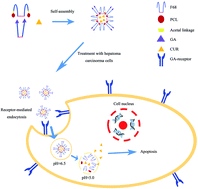Glycyrrhetinic acid modified and pH-sensitive mixed micelles improve the anticancer effect of curcumin in hepatoma carcinoma cells
Abstract
Curcumin (CUR), a natural polyphenolic compound existing in plants, exhibits anticancer potential in inhibiting the growth of various types of human cancer. However, the poor aqueous solubility and low bioavailability limit its clinical applications. pH-sensitive macromolecule F68-acetal-PCL (FAP) and active targeting macromolecule F68-glycyrrhetinic acid (FGA) were designed to fabricate mixed micelles for efficient delivery of CUR. The thin film hydration method was used to prepare CUR loaded mixed (MIX/CUR) micelles. The drug loading rate (DL) of MIX/CUR micelles was 6.31 ± 0.92%, which remained stable for 15 days at 4 °C. The particle size and zeta potential of the MIX/CUR micelles were 91.06 ± 1.37 nm and −9.79 ± 0.47 mV, respectively. The MIX/CUR micelles exhibited pH sensitivity in a weak acid environment, and showed rapid particle size variation and drug release. In addition, in vitro tests demonstrated that MIX/CUR micelles induced higher cytotoxicity and apoptosis than free CUR, non-pH-sensitive F68-PCL (FBP)/CUR micelles and pH-sensitive FAP/CUR micelles in SMMC7721 and Hepa1-6 cells. Besides, mixed micelles were more effective than FBP and FAP micelles in a cell uptake experiment, which was medicated by a GA receptor. All in all, these results indicated that MIX/CUR micelles could be regarded as an ideal drug administration strategy against hepatoma carcinoma cells.



 Please wait while we load your content...
Please wait while we load your content...